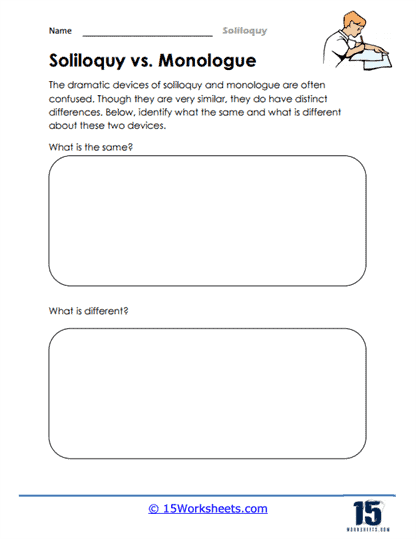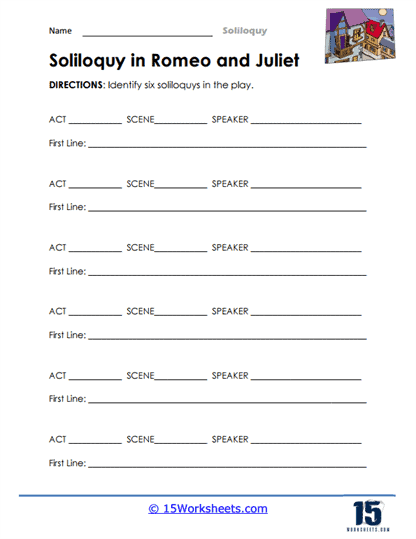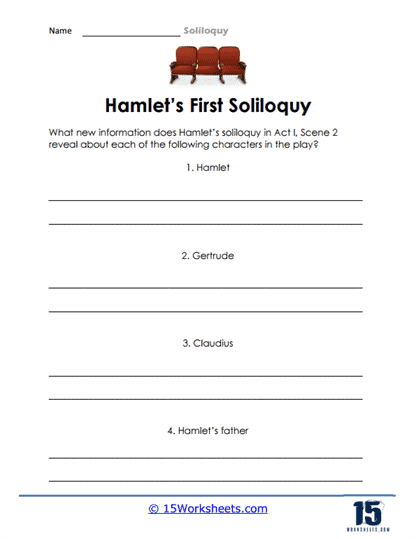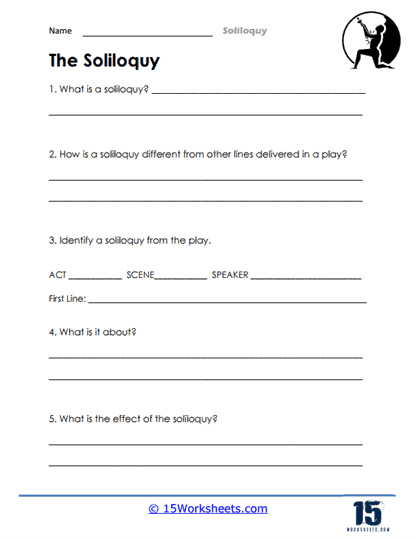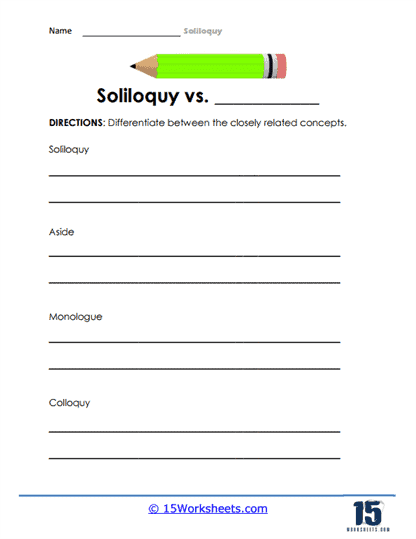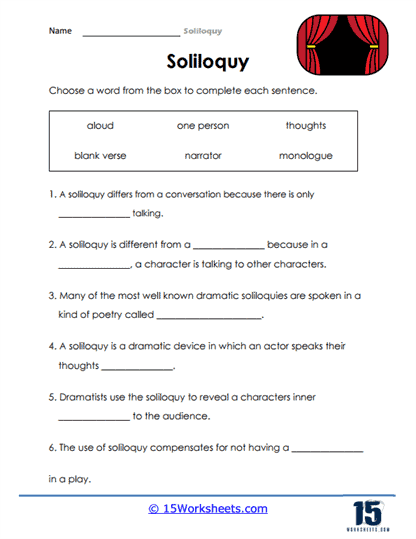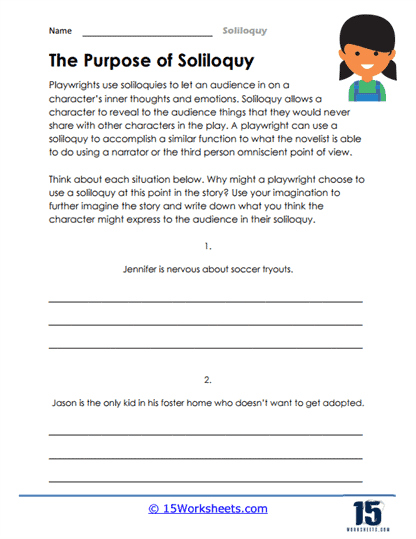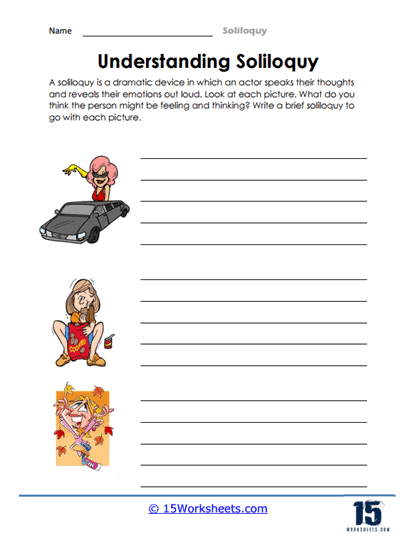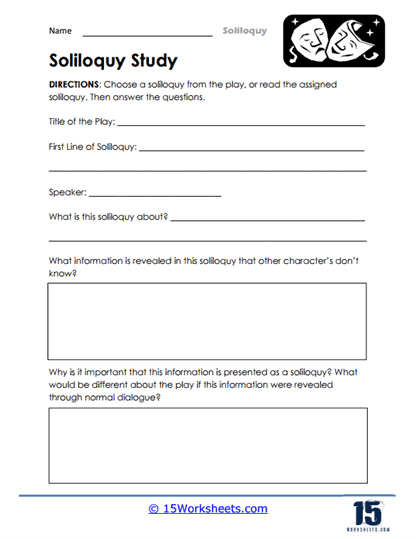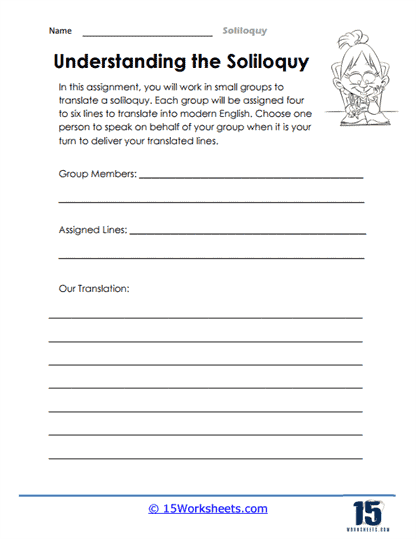Soliloquy Worksheets
About These 15 Worksheets
These worksheets will deepen students’ understanding and appreciation of the soliloquy as a literary device. A soliloquy is a powerful moment in drama where a character speaks their thoughts aloud, typically alone on stage, revealing their innermost feelings, thoughts, and plans to the audience. This device is crucial for character development, thematic exploration, and advancing the plot in dramatic works. Soliloquy worksheets guide students through a variety of exercises that focus on analysis, interpretation, performance, and creative writing, enhancing their engagement with literature and improving their language arts skills.
These worksheets are structured to provide a comprehensive exploration of soliloquies across various plays and literary contexts. They aim to help students identify soliloquies, understand their content and significance, analyze the language and emotions expressed, and appreciate their impact within the narrative. By working through these exercises, students not only improve their analytical skills but also enhance their ability to empathize with characters and understand complex literary themes.
Types of Exercises
Identification – These tasks require students to identify passages as soliloquies, distinguishing them from monologues or dialogues. This foundational exercise helps students recognize the solitary nature of a soliloquy and its purpose in drama.
Interpretation and Analysis Exercises – Students are asked to interpret the soliloquy’s meaning, analyze the character’s state of mind, and explore the language and literary devices used. This includes examining metaphor, simile, imagery, and any other figures of speech to understand how they contribute to the character’s expression.
Contextual – These exercises place soliloquies within the broader context of the play, asking students to consider how the soliloquy advances the plot, reveals character development, or highlights themes. Students might compare the soliloquy to other scenes or characters’ actions to gauge its significance.
Performance – Encouraging students to perform soliloquies can deepen their understanding of the emotional and psychological depth of the piece. These exercises may involve reading aloud, acting out the soliloquy, or even directing classmates in a performance, focusing on intonation, gesture, and expression to convey the character’s internal state.
Creative Writing – Students might be tasked with writing their own soliloquies for a character from a play or an original character they develop. This exercise fosters creativity, requires a deep understanding of the soliloquy’s function, and enhances empathy by encouraging students to delve into a character’s psyche.
Comparative Analysis – These tasks involve comparing soliloquies across different works or characters, examining how different playwrights employ soliloquies to achieve various effects. Such comparisons can highlight differences in themes, character development, and dramatic style.
Reflection and Discussion – Students reflect on the impact of the soliloquy on their understanding of the character and the play. Discussions, either in groups or as a class, can facilitate deeper insights and diverse interpretations, enhancing critical thinking skills.
The Impact Of These Worksheets
Practicing with soliloquy worksheets can significantly enhance students’ language arts and reading skills in several ways:
Improved Analytical Skills – By dissecting soliloquies, students hone their ability to analyze text, identify literary devices, and interpret complex language and themes. This analytical prowess is crucial for understanding not only dramas but all forms of literature.
Enhanced Comprehension – Working through soliloquies with guided exercises improves students’ comprehension of dramatic texts, enabling them to grasp nuanced expressions of emotion, character motivations, and plot developments.
Developed Empathy and Emotional Intelligence – Performing and writing soliloquies encourage students to put themselves in a character’s shoes, fostering empathy and a deeper emotional connection to literature.
Increased Engagement with Texts – The active processes of analysis, performance, and creative writing make literature more engaging and accessible, encouraging students to explore texts beyond surface-level readings.
Strengthened Communication Skills – Analyzing and performing soliloquies enhances students’ oral and written communication skills, as they learn to express complex ideas and emotions clearly and effectively.
Expanded Vocabulary and Appreciation for Language – Soliloquies often contain rich, expressive language. Working with these passages can expand students’ vocabularies and foster an appreciation for the beauty and power of language.
Cultivated Critical Thinking – The reflective and comparative exercises in soliloquy worksheets promote critical thinking, as students evaluate different interpretations and consider how soliloquies contribute to the broader narrative and themes of a play.
What is the Literary Device of Soliloquy?
Soliloquy is a powerful literary device used extensively in drama and, to a lesser extent, in prose, allowing characters to speak directly to the audience, or ostensibly to themselves, revealing their innermost thoughts, feelings, and plans. This device is crucial for deepening the audience’s understanding of a character’s psyche, motivations, and conflicts, serving as a window into the character’s soul. Unlike a monologue or an aside, a soliloquy is not meant to be heard by other characters in the play, making it a unique tool for conveying unspoken truths and internal struggles.
The Defining Feature of a Soliloquy
The main defining feature of a soliloquy is its introspective and often philosophical nature, giving voice to the character’s innermost thoughts without the pretense of interaction with other characters. It is a moment of pure self-reflection, where the character is alone on stage, engaging directly with the audience or speaking to themselves. This unfiltered insight into the character’s mind is what sets soliloquies apart from other types of dramatic speech.
Characteristics of a Soliloquy
Exposition – Soliloquies often serve to provide crucial background information or context to the audience, helping to advance the plot or deepen the narrative complexity.
Revealing Inner Thoughts – They reveal the motives, plans, and feelings of the character, often including doubts, moral dilemmas, or contemplations of significant decisions.
No Direct Audience – While delivered to the audience in a theater, within the context of the story, soliloquies are spoken to no one else on stage, distinguishing them from dialogues and asides.
Dramatic Irony – By sharing the character’s true intentions or feelings with the audience, soliloquies can create dramatic irony, enhancing the emotional and psychological depth of the narrative.
Reflection and Decision Making – Characters often use soliloquies to weigh their options, reflect on past actions, and decide on future actions, making these speeches crucial turning points in the narrative.
Examples of Soliloquies in Literature
Hamlet’s “To be, or not to be” (William Shakespeare, “Hamlet”) – Perhaps the most famous soliloquy in English literature, Hamlet contemplates the nature of existence and the appeal of suicide to escape the pain of life. This soliloquy reveals Hamlet’s profound existential crisis, his indecision, and his philosophical depth, inviting the audience into his tortured psyche and illustrating his isolation.
Macbeth’s “Tomorrow, and tomorrow, and tomorrow” (William Shakespeare, “Macbeth”) – After hearing of Lady Macbeth’s death, Macbeth reflects on the futility and brevity of life, comparing it to a brief candle and a tale told by an idiot, full of sound and fury, signifying nothing. This moment underscores Macbeth’s descent into nihilism, his realization of the hollow victory of power, and the inevitability of death.
Juliet’s soliloquy on the balcony (William Shakespeare, “Romeo and Juliet”) – Juliet, unaware that Romeo is listening, muses on the nature of names and her love for Romeo, despite his being a Montague. This soliloquy highlights Juliet’s innocence, her deep feelings for Romeo, and the arbitrary nature of the feud between their families, setting the stage for the tragedy that unfolds.
The Effect of Soliloquy on the Reader
Soliloquies have a profound effect on the audience or reader, creating a sense of intimacy and direct engagement with the characters. This device allows the audience to understand the motivations and vulnerabilities of characters in a way that dialogue with other characters cannot achieve. The insight provided by soliloquies engenders empathy, making the audience more invested in the characters’ fates.
Soliloquies can heighten the drama and tension of a narrative, as the audience is privy to information that other characters are not, creating dramatic irony. This knowledge can intensify the emotional impact of the story, as the audience anticipates the consequences of the character’s actions based on their revealed intentions and feelings.
Soliloquies are a crucial tool for authors and playwrights to explore and convey the complexity of human nature, providing a direct conduit to the character’s soul. Through this device, literature and drama can transcend mere storytelling, offering deep insights into the human condition and the philosophical questions that define our existence.


